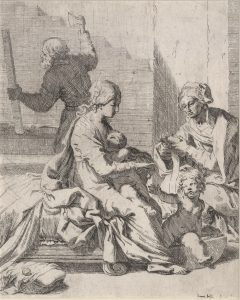Elisabetta Sirani: Artist of Bologna
Women artists working during the 16th and 17th centuries were few, or that is, only a small number came to prominence in the Western canon of art. This may be explained by the many obstacles placed in the way of aspiring female artists, for unlike their male counterparts, they had no guild to support them, which in turn made earning a living through the sale of their art very difficult. [1.] Students of art history are frustrated by this, and lament their under representation in both the history books and in the Baillieu’s Print Collection. Thus, it is a pleasure to highlight one of the women who triumphed over the challenges and became a renowned artist of Bologna: Elisabetta Sirani (1638-1665).
She was taught by her father Giovanni Andrea Sirani (1610-1670) who was also an artist, one that she surpassed in both reception, and in the number of works produced. When he became ill, Elisabetta ran the family studio, and she went on to found a school for women painters. Paintings make up most of her corpus, however, she also made drawings and was a printmaker.

The etching Holy Family with St Elizabeth and St John the Baptist (1655-56), is not after another famous work of art by a male artist, but is rather a design of her own. It conveys an intimate domestic scene with the Virgin Mary nursing Christ and amusing the infant Saint John by dangling an object from her hand. An aging Saint Elizabeth is perhaps winding swaddling cloth, and in the background, Saint Joseph is at work with wood and axe. The architectural devices that dynamically intersect the backdrop are a clever compositional feature.
Reference
[1.] Caroline P. Murphy, ‘The economics of the woman artist,’ in Italian women artists: from Renaissance to Baroque, Milano: Skira; New York, NY: Distributed in North America by Rizzoli International, c2007, p. 23

Leave a Reply